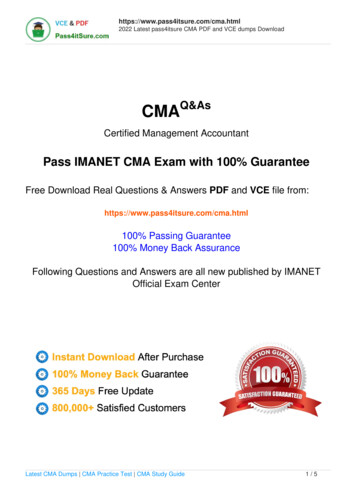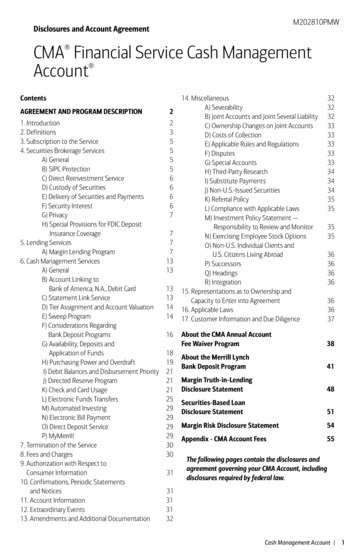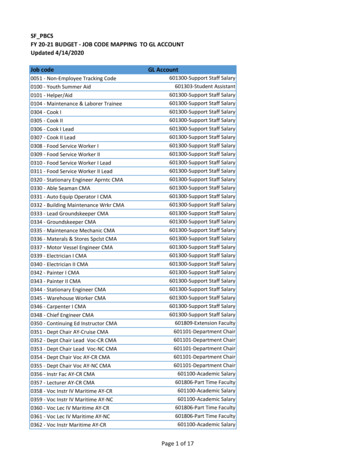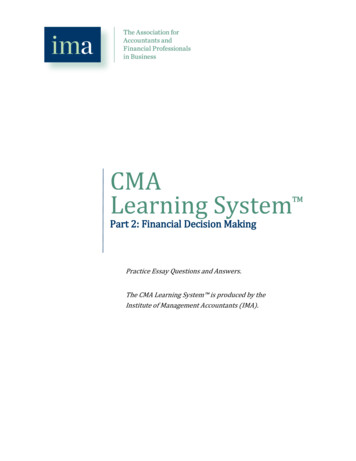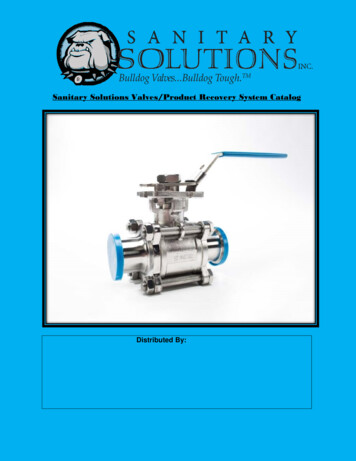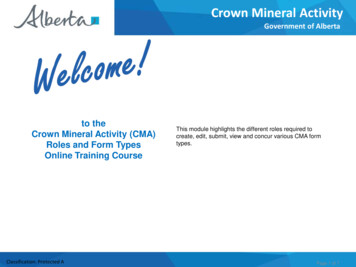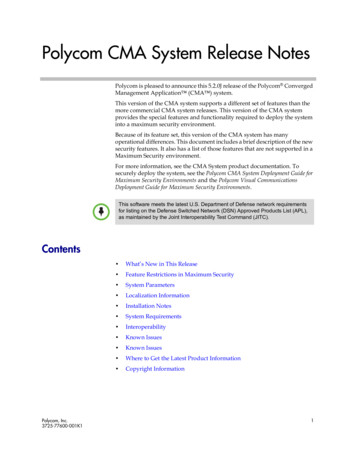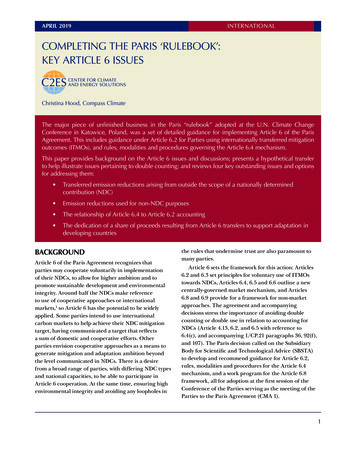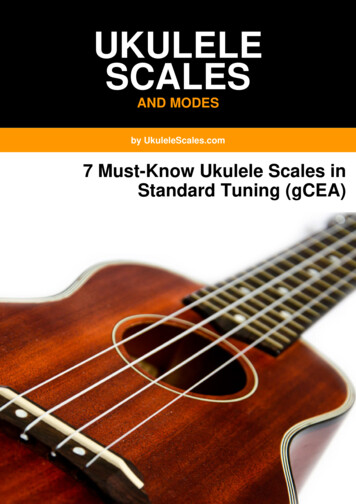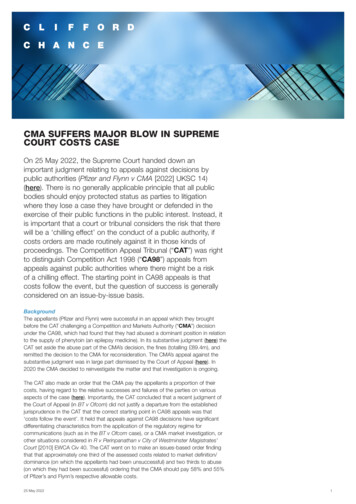
Transcription
CMA SUFFERS MAJOR BLOW IN SUPREMECOURT COSTS CASEOn 25 May 2022, the Supreme Court handed down animportant judgment relating to appeals against decisions bypublic authorities (Pfizer and Flynn v CMA [2022] UKSC 14)(here). There is no generally applicable principle that all publicbodies should enjoy protected status as parties to litigationwhere they lose a case they have brought or defended in theexercise of their public functions in the public interest. Instead, itis important that a court or tribunal considers the risk that therewill be a ‘chilling effect’ on the conduct of a public authority, ifcosts orders are made routinely against it in those kinds ofproceedings. The Competition Appeal Tribunal (“CAT”) was rightto distinguish Competition Act 1998 (“CA98”) appeals fromappeals against public authorities where there might be a riskof a chilling effect. The starting point in CA98 appeals is thatcosts follow the event, but the question of success is generallyconsidered on an issue-by-issue basis.BackgroundThe appellants (Pfizer and Flynn) were successful in an appeal which they broughtbefore the CAT challenging a Competition and Markets Authority (“CMA”) decisionunder the CA98, which had found that they had abused a dominant position in relationto the supply of phenytoin (an epilepsy medicine). In its substantive judgment (here) theCAT set aside the abuse part of the CMA’s decision, the fines (totalling 89.4m), andremitted the decision to the CMA for reconsideration. The CMA’s appeal against thesubstantive judgment was in large part dismissed by the Court of Appeal (here). In2020 the CMA decided to reinvestigate the matter and that investigation is ongoing.The CAT also made an order that the CMA pay the appellants a proportion of theircosts, having regard to the relative successes and failures of the parties on variousaspects of the case (here). Importantly, the CAT concluded that a recent judgment ofthe Court of Appeal (in BT v Ofcom) did not justify a departure from the establishedjurisprudence in the CAT that the correct starting point in CA98 appeals was that‘costs follow the event’. It held that appeals against CA98 decisions have significantdifferentiating characteristics from the application of the regulatory regime forcommunications (such as in the BT v Ofcom case), or a CMA market investigation, orother situations considered in R v Perinpanathan v City of Westminster Magistrates’Court [2010] EWCA Civ 40. The CAT went on to make an issues-based order findingthat that approximately one third of the assessed costs related to market definition/dominance (on which the appellants had been unsuccessful) and two thirds to abuse(on which they had been successful) ordering that the CMA should pay 58% and 55%of Pfizer’s and Flynn’s respective allowable costs.25 May 20221
CMA SUFFERS MAJOR BLOW IN SUPREMECOURT COSTS CASEOn appeal, the Court of Appeal set aside that order (here), finding that the CAT haddisregarded a principle that had developed through the common law, in particular inthe cases of Bradford Metropolitan District Council v Booth [2000] 164 JP 485,Baxendale-Walker v Law Society [2007] EWCA Civ 233, and Perinpanathan (the“Booth Line of Cases”). The principle was that, in the absence of an express rule,the starting point is that no order for costs should be made against a public body thathas been unsuccessful in defending proceedings in the exercise of its statutoryfunctions (the “Principle”). The default position may be departed from for good reason(e.g. unreasonable conduct by the regulator or financial hardship), but the mere factthat a regulator has been successful is not, without more, a good reason. Permissionto appeal was granted by the Supreme Court, with interventions from a number ofthird parties including the Office of Communications (“Ofcom”) and the SolicitorsRegulation Authority (“SRA”) culminating in a two-day hearing in February 2022.The appeal before the Supreme CourtBefore the Supreme Court the appellants argued that there was no such Principleand that the Court of Appeal was wrong to hold that the CAT’s discretion should beconstrained by any such Principle. The Booth Line of Cases established only that animportant factor for a court or tribunal to take into account when considering costs iswhether there is a risk that making an adverse costs order will have a chilling effecton the relevant public body (i.e. that they might be discouraged from making andstanding by decisions which they take reasonably in the public interest). Further, theappellants argued that the CAT was best placed to consider whether there was a riskof such a chilling effect, as regards the different public bodies that regularly appearbefore it. There was, furthermore, no reason to adopt a ‘no order as to costs’ startingpoint in appeals like this one and every reason in general to award costs to asuccessful appellant.In her judgment, Lady Rose agreed with Perinpanathan that even where a statutorypower conferred on a court or tribunal to award costs appears to be unfettered, as inthis appeal, it is appropriate for an appellate court to lay down guidance or even ruleswhich should apply in the absence of special circumstances [94]. The main issueraised in the appeal was whether there is a general principle that a court or tribunal,exercising such discretion, should adopt as its starting point that it will not make anorder for costs where the unsuccessful respondent is a public body defending adecision which it has taken in the exercise of its functions in the public interest, unlessthere is some good reason to do so (the lack of success not being of itself a goodreason) [95]. If there was no such general principle, the next question was whether theCAT nonetheless erred in adopting a starting point of costs follow the event in CA98appeals by failing to give adequate consideration to the position of the CMA and therisk of a chilling effect on the CMA [96].Is there a general principle protecting public bodies defending decisions takenin the public interest from adverse costs orders?In its judgment the Supreme Court found that there was no generally applicableprinciple that all public bodies should enjoy a protected status as parties to litigation.Instead, where a public body is unsuccessful in proceedings, an important factor that acourt or tribunal should take into account is the risk that there will be a chilling effecton the conduct of the public authority, if costs orders are made routinely against it inthose kinds of proceedings. The court does not have to consider the point afresh eachtime it exercises its discretion.2May 2022
CMA SUFFERS MAJOR BLOW IN SUPREMECOURT COSTS CASEThe Supreme Court found that there is a general risk of a chilling effect in the kinds ofproceedings dealt with in the Booth Line of Cases (Booth involved an appeal beforethe magistrates’ court relating to a vehicle licensing decision taken by a local authority,Baxendale-Walker was a disciplinary proceeding against a solicitor before the SolicitorsDisciplinary Tribunal, and Perinpanathan concerned a failed application by a ChiefConstable for forfeiture of money seized and retained under the Proceeds of Crime Act2002) and to analogous proceedings. However, it did not consider that in everysituation and for every public body it must be assumed that there might be such achilling effect and that the body should be shielded from the costs consequences ofthe decisions it takes. Whether there is a real risk of such a chilling effect depends onthe facts and circumstances of the public body in question and the nature of thedecision which it is defending [97-98]. The relevant court or tribunal is best placed toassess arguments on the risk of a chilling effect.The Supreme Court did not agree that the Court of Appeal’s judgment in BT v Ofcomwas authority for the proposition that in all cases where the party to an appeal beforethe CAT is a public body, there must be a presumption or starting point that no orderfor costs should be made against that body [103]. Such an approach disregards thefact that, in BT v Ofcom, the Court of Appeal remitted to the CAT expressly so that theCAT could reconsider the applicable starting point. That was because the Court ofAppeal recognised that the CAT is itself best placed to consider the arguments onchilling effect advanced by both sides [104].Did the CAT fail to give adequate consideration of the risk of a chilling effecton the CMA?The Supreme Court observed that the CAT had considered the relevance of thepotential chilling effect of costs orders during various appeals. The CAT’s practice ofadopting a starting point of costs follow the event in appeals under the CA98 was wellestablished by the time the CAT’s rules were reviewed and revised in 2015. By thattime the CAT had taken the chilling effect arguments into account by adopting a noorder as to costs starting point in relation to some kinds of proceedings, but in CA98proceedings, it had determined that those arguments did not militate against a costsfollow the event starting point. The revised 2015 rules carried forward the broaddiscretion of the CAT and did not add a potential chilling effect to the list of factors theCAT might take into account when considering costs [120].The Supreme Court found that the level of decision-making activity of local authorities,the police and professional disciplinary bodies is of an entirely different order from thatof the CMA. The CMA takes a limited number of decisions each year under the CA98[121]. Further, as a result of the arrangement between the CMA and HM Treasury(whereby any legal costs can be offset against the CMA’s income from fines) there isno adverse effect on the CMA’s finances arising from a liability to pay the costs of asuccessful appellant [125], which dispels any plausible concern that the CMA’sconduct will be influenced by the risk of adverse costs orders [123]. Instead, the CMAis incentivised to investigate and sanction infringements by substantial undertakingseven though they may be more likely to appeal against a decision and likely to spendmore on that appeal. The adoption of a costs follow the event starting point does notappear to have deterred the CMA from pursuing major market participants [126].May 20223
CMA SUFFERS MAJOR BLOW IN SUPREMECOURT COSTS CASEIn the Supreme Court’s judgment, the CAT was right to distinguish the nature ofdecisions taken by the public authorities in the Booth Line of Cases, from the decisionstaken by the CMA under the CA98 [130]. The CAT is well aware of the manycompeting factors pulling in different directions in the different jurisdictions in whichit operates. It has developed a sophisticated approach to costs awards striking abalance between (a) maintaining flexibility whilst providing predictability and(b) ensuring that costs awards do not undermine the effectiveness of the competitionor regulatory regime whilst ensuring a just result for both parties [153]. The analysis inthe CAT’s costs ruling in this case was a proper exercise of its costs jurisdiction,arrived at after considering all relevant factors [154]. The CAT had considered in detailthe arguments on chilling effect advanced by both sides and adopted a consistent andsustainable approach, based not on fine distinctions between the routes by whichcases reach the CAT, but on applicable legal principle, the specific industry positionbest understood by the CAT itself, and its own procedural rules. The CAT was entitledto conclude that the substantive legislative framework and the applicable proceduralprovisions relevant to assessing the starting point in CA98 cases do not point towardsa different answer [155].CommentThe Supreme Court’s judgment is important in the context of appeals against decisionsby public authorities. It has found that there is no generally applicable principle that allpublic bodies should enjoy protected status as parties to litigation where they lose acase they have brought or defended in the exercise of their public functions in thepublic interest. Rather than a ‘general principle’, it is important that a court or tribunalconsiders the risk that there will be a chilling effect on the conduct of a public authority,if costs orders are made routinely against it in those kinds of proceedings. Morespecifically in relation to appeals against CA98 decisions, the CAT was right todistinguish these from the Booth Line of Cases. The starting point in these appeals isthat costs follow the event, but the question of success is generally considered on anissue-by-issue basis.The judgment is significant for appellants against CA98 decisions by the CMA andother competition authorities. Undertakings that have been found to have infringedcompetition law have already been subject to lengthy investigations, often lasting manyyears, and leading to significant costs none of which are recoverable. Had the Court ofAppeal’s judgment been upheld, even undertakings who had successfully appealed aCA98 decision before the CAT could not have recovered any of their costs, absentexceptional circumstances. Such a regime may have significantly deterred companiesfrom appealing CA98 decisions even where they regarded the decisions as wrong. Itmust be hoped that the maintenance of costs risk for the CMA should it fail to defendits decisions will result in robust, fair and proportionate decision making. This judgmentfrom the Supreme Court strikes the right balance in ensuring that, if an appellantsucceeds in its appeal before the CAT, then it will be able to recover its reasonablecosts from the CMA.Clifford Chance acted for Pfizer in its appeal before the Supreme Court, during theCMA’s investigation and Pfizer’s subsequent successful appeals in phenytoin.4May 2022
CONTACTSThis publication does not necessarily deal with every importanttopic or cover every aspect of the topics with which it deals.It is not designed to provide legal or other advice.www.cliffordchance.comClifford Chance, 10 Upper Bank Street, London, E14 5JJ Clifford Chance 2022Elizabeth MoronyPartnerLondonT: 44 207006 8128E: elizabeth.morony@cliffordchance.comMatthew ScullyPartnerLondonT: 44 207006 1468E: matthew.scully@cliffordchance.comLuke TolainiPartnerLondonT: 44 207006 4666E: luke.tolaini@cliffordchance.comClifford Chance LLP is a limited liability partnership registeredin England and Wales under number OC323571Registered office: 10 Upper Bank Street, London, E14 5JJWe use the word ‘partner’ to refer to a member ofClifford Chance LLP, or an employee or consultant withequivalent standing and qualificationsIf you do not wish to receive further information fromClifford Chance about events or legal developments whichwe believe may be of interest to you, please either send anemail to nomorecontact@cliffordchance.com or by post atClifford Chance LLP, 10 Upper Bank Street, Canary Wharf,London E14 5JJSamantha WardPartnerLondonT: 44 207006 8546E: samantha.ward@cliffordchance.comBen JasperSenior AssociateLondonT: 44 207006 8092E: ben.jasper@cliffordchance.comHelene AlmasSenior AssociateLondonT: 44 207006 5482E: helene.almas@cliffordchance.comAbu Dhabi Amsterdam Barcelona Beijing Brussels Bucharest Casablanca Delhi Dubai Düsseldorf Frankfurt Hong Kong Istanbul London Luxembourg Madrid Milan Moscow Munich Newcastle New York Paris Perth Prague Rome São Paulo Shanghai Singapore Sydney Tokyo Warsaw Washington, D.C.Clifford Chance has a co-operation agreement with AbuhimedAlsheikh Alhagbani Law Firm in Riyadh.AUTHORSClifford Chance has a best friends relationship with RedcliffePartners in Ukraine.The Clifford Chance Moscow office will be closed with effectfrom 31 May 2022.Ben JasperSenior AssociateLondonT: 44 207006 8092E: ben.jasper@cliffordchance.comHelene AlmasSenior AssociateLondonT: 44 207006 5482E: helene.almas@cliffordchance.com2205-001296
of the CMA. The CMA takes a limited number of decisions each year under the CA98 [121]. Further, as a result of the arrangement between the CMA and HM Treasury (whereby any legal costs can be offset against the CMA's income from fines) there is no adverse effect on the CMA's finances arising from a liability to pay the costs of a
